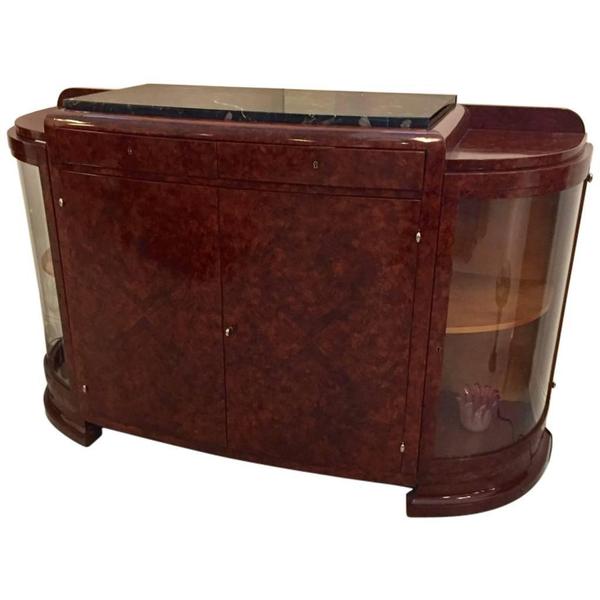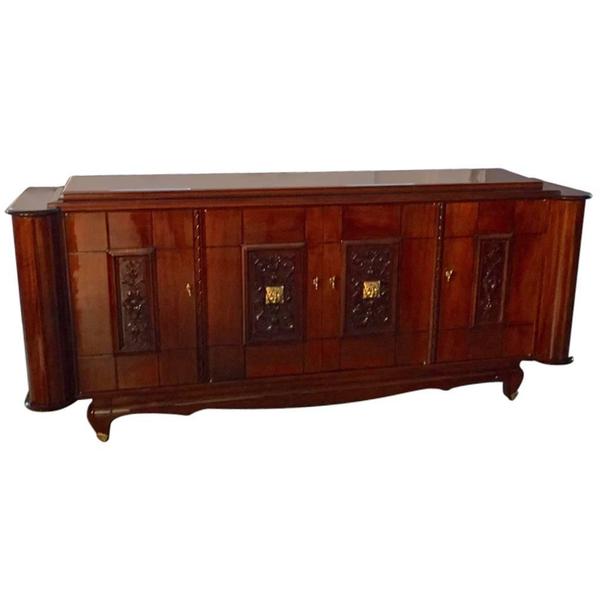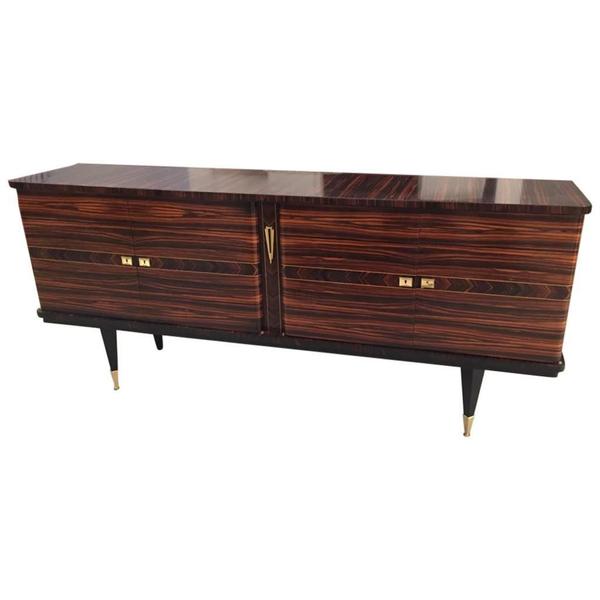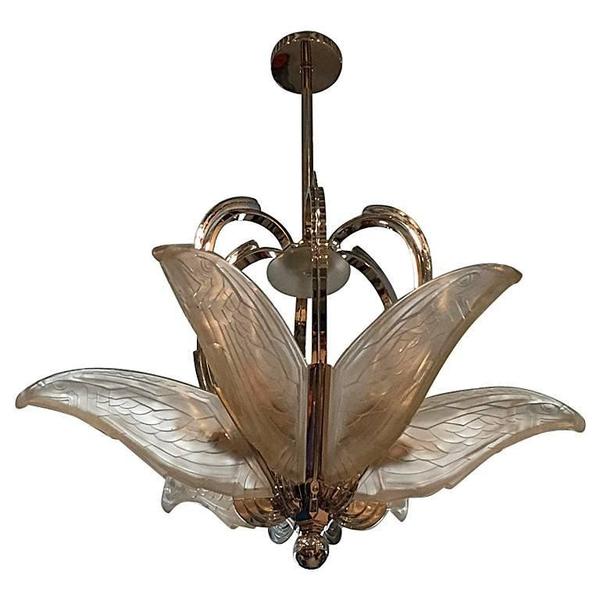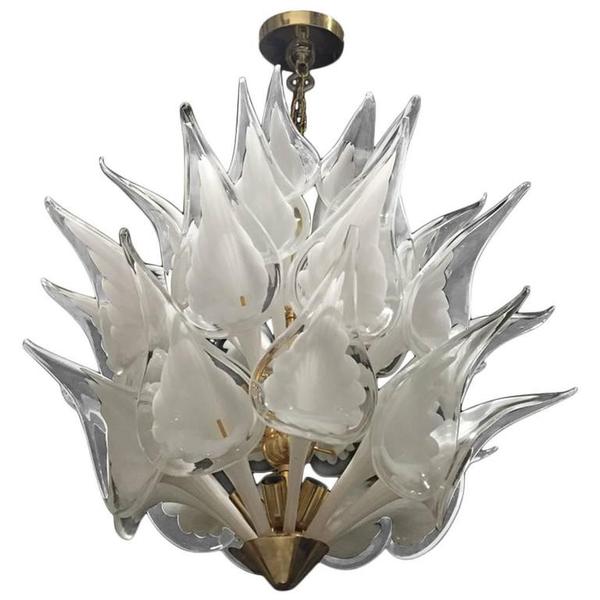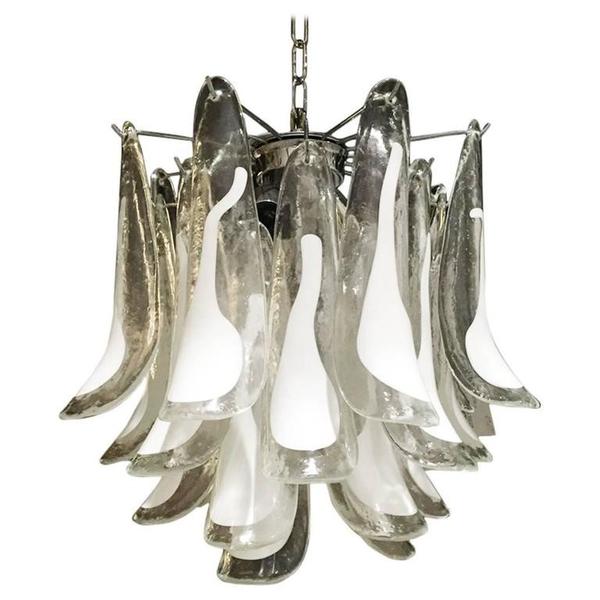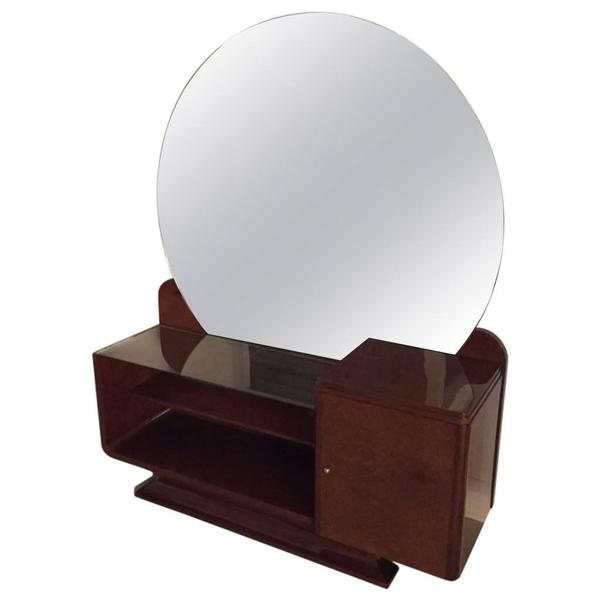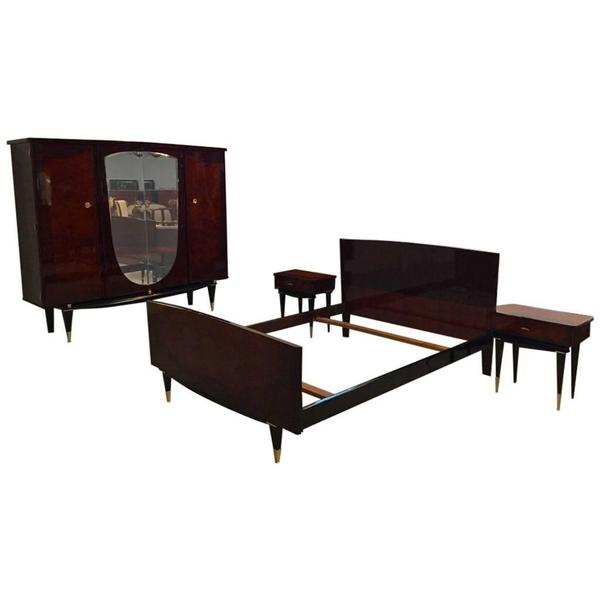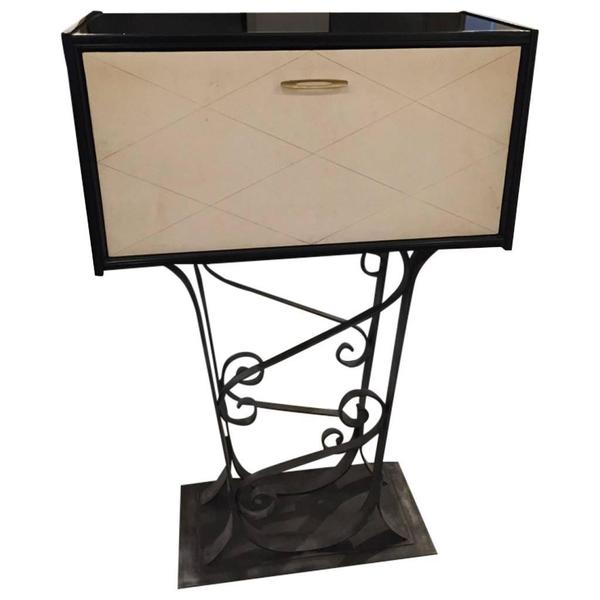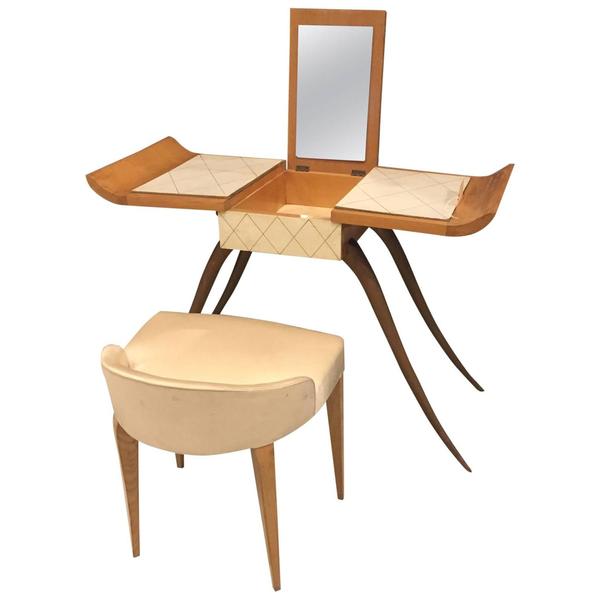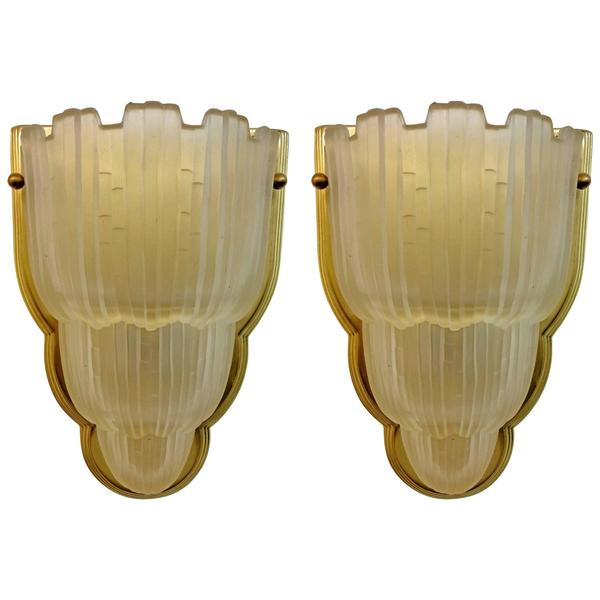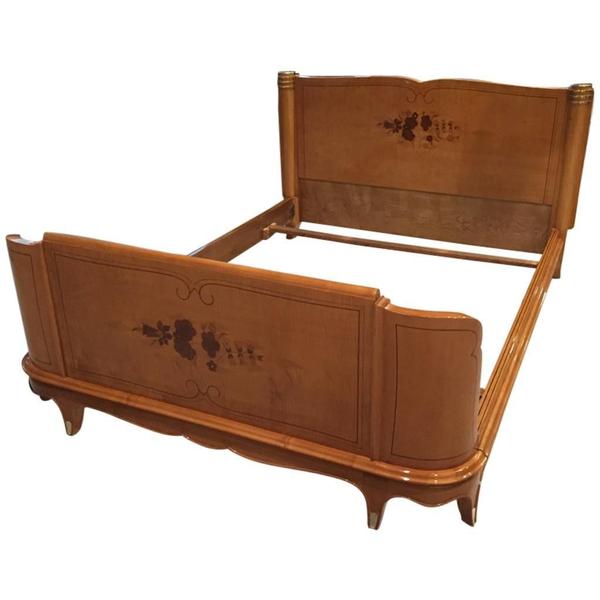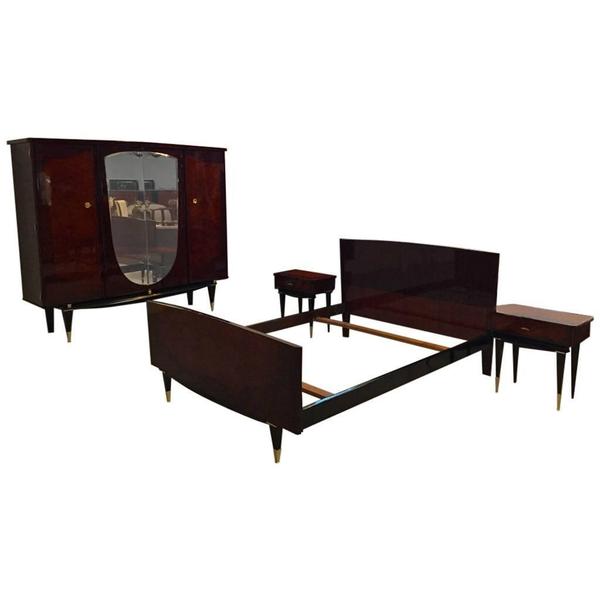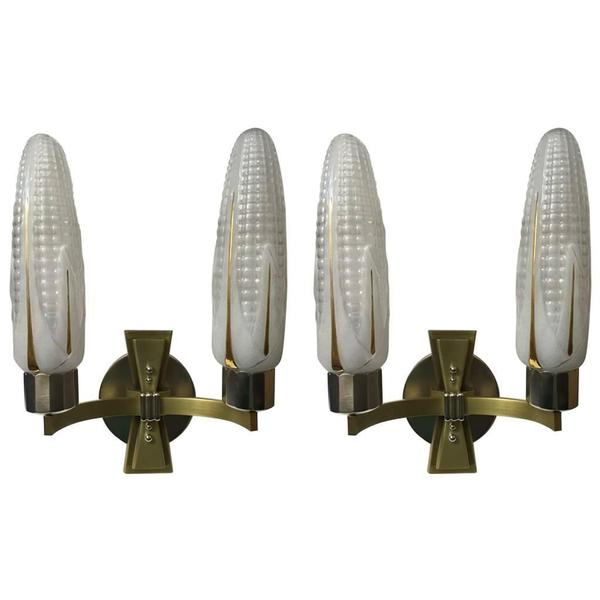Blog
Five Great Reasons to Get a Buffet 0
Buffets are one of those pieces of furniture that is often overlooked while decorating and furnishing the home. To me, that's crazy, because the right buffet in your dining room can make a massive difference to your enjoyment of the space.
Besides the added style element that a well-chosen buffet can add to your overall decor, buffets are genuinely useful pieces of furniture. Here are five really good reasons why you should consider getting one.
French Art Deco Buffet with Portoro Marble Top
Maximize storage space
Many newer homes come with less storage space than one would ideally like. I know in many of the homes I see, most of the kitchen's cupboard space is taken up by food and cooking utensils, leaving very little space for flatware, silverware and glasses.
A buffet takes care of that storage space hassle in one, neat and attractive package. Even a small buffet usually has more than enough space for all your cutlery, crockery and drinking glasses, plus that delicate bone china tea set Aunt Mabel gave you at your wedding that's been hiding in a box at the top of your closet for years.
Bronze Face French Art Deco Buffet
Less table clutter
Everybody loves a good dinner party - it's full of good food, good wine and good conversation. It's also usually full of clutter. All the food dishes, glasses, bottles of wine, condiments and whatever else has been crammed onto the table takes up a lot of space, and often makes for one big mess.
By shifting all the food serving dishes and utensils, as well as the bottles of drinks, off the table and onto the buffet, you've made the table less cluttered, and you've added a freer, more comfortable atmosphere where people aren't constantly having to avoid stuff.
French Art Deco Exotic Macassar Ebony Buffet With Dry Bar, circa 1940s
Easier serving
Along with the clutter comes serving difficulty. No matter how carefully you place the various food dishes on your dining table, there's going to be a lot of reaching across the table to get at things.
That, again, translates to a big mess, not to mention the jostling, sleeves dangling in soup and tangle of arms all trying to grab a roast potato before they're all gone.
A buffet allows for neat, orderly dishing of food and seating, and also makes it super easy for anyone who wants seconds to get them. You can also keep your drinks bottles and decanters neatly on one end, making it simple to top up glasses when needed.
Space saving
This may seem counter-intuitive; after all, it is a whole other piece of furniture to fit into the dining room. However, a buffet itself doesn't take up a whole lot of room, and it allows you to reconsider various other furniture options.
For example, many people buy a too-big dining table to accommodate all the various food dishes that it needs to accommodate. By using a buffet ever day, you can opt for a family-size table rather than a party-size one.
You also won't need to buy additional free-standing shelves or cupboards to store your flatware, silverware and glasses. Those can all fit in the buffet, no problem.
French Art Deco Palisander Buffet
Character
A dining room can be a difficult room to add character to. It usually includes nothing more than a table and some chairs, and the occasional painting or mirror on the wall. A buffet, however, helps you add character to the room, along with your carefully selected lighting, in two ways:
Firstly, in itself it is a decor item which adds to the room's overall design; secondly, it is a handy surface on which you can place one or two decorative items, including a table lamp, that add those little finishing touches to round out the room.
Buffets are a great addition to any dining room, and next time, we'll take a look at how to choose the perfect buffet for your home and needs.
- Matthew Pillet
- Tags: buffet credenza dining room living room sideboard
A Chandelier for All Seasons 0
Regardless of what size house you live in, a chandelier is always an incredible way to not only literally brighten up a room, but also figuratively brighten it. By choosing the right chandelier for each room of the house, you bring in personality, style and an indelible statement that this room may serve a purpose, but it's also there for enjoying.
But which rooms should you put a chandelier in? Honestly, I'd put one in every single room... yes, even the bathroom. Why on earth not? Let's have a look at a few ideas for choosing chandeliers for different rooms of the house.
Dining room
French Art Deco Chandelier with Geometric Flying Bird Motif
I've spoken before about lighting up your dining room, so we won't get into too much detail about brightness, except to say, this is one room where you want to be able to see what you're doing. If you want atmosphere, you can always install a dimmer switch, but you need good lighting here.
This is also the room where you will - hopefully - do the bulk of your indoor entertaining, so glam it up here. Choose the chandelier that best expresses your love of Art Deco or Mid-century Modern, and make it the one with the most effective lighting.
Top tip: For dining rooms, because you will be seated most of the time, and won't move around under the chandelier, you have the option of lower-hanging chandeliers. As long as it doesn't obstruct the conversation!
Living room
Mid-Century Italian Camer Calla Lily Murano Glass Chandelier
Living room lighting depends on what you primarily do in there. If you spend a lot of time watching TV, you may want lower-level lighting, while a more entertainment-oriented living room needs a bit more. Either way, try to match your chandelier to the tone of the room.
If you have gone all out with your Art Deco or mid-century Modern stylings in this room, then don't hesitate to go all out with a suitable chandelier. For a more understated design pallette, choose a simpler style.
Top tip: You don't want the chandelier to get in the way of comfortable movement, so choose chandeliers that don't hang too low. If you want plenty of lighting, wider is better than lower-hanging.
Kitchen
Your kitchen is another area that needs a lot of lighting to avoid accidentally cutting yourself or using the wrong spices. For evenly distributed lighting, depending on the size of your kitchen, two or even three smaller, matching chandeliers are ideal.
While you can certainly choose a glamorous style, bear in mind that kitchens are full of steam and other vapors, so the chandelier can get grubby-looking quickly. Choose one that will be easier to clean
Top tip: For ease of cleaning, choose a chandelier that has removable parts. For example, if the glass fitting can be taken down to clean, it means less chances of breakage.
Bathroom
Italian Mid-Century Two-Tiered Chandelier by Gaetano Sciolari
Bathrooms - except for ultra-fancy ones in very large homes - tend to be much smaller and more functional than any other rooms. When choosing a chandelier for this room, look for something small but beautiful.
Like with the kitchen, this one will be subjected to a lot of steam, so something that's easier to clean is never a bad idea.
Top tip: Choose a chandelier here that is fairly sturdy. If you accidentally get a towel caught on it, you don't want baubles and parts to go flying.
Bedroom
Italian Mid-Century White Feather Glass Chandelier by Mazzega
Ah, the room where all the "swinging from the chandelier" happens (Don't swing from the chandelier, it will break!). Bedrooms are, usually, less of an entertainment area and more of a relaxation area. This doesn't mean you can't have a glamorous and beautiful chandelier, though.
Choose something highly decorative but with lower lighting levels for the bedroom - always bearing your furniture's styles in mind, of course. This is one room where what you want goes and you get to completely indulge your fantasies of palatial living - even if it is a small room. Go ahead and spoil yourself here with something really gorgeous.
Top tip: Consider the movement that may happen in the dark. You don't want to be caught in baubles on your way to the bathroom at 4 a.m. Plan your placement carefully.
- Matthew Pillet
Choosing the Best Art Deco Style for Your Home 0
We talk a lot about Art Deco, how to inject a little of its styles and influences into your home, how to create an Art Deco palace... but what is Art Deco? Is it a single, unified style? Can you just buy a few Art Deco pieces and voilà, you have a Great Gatsby masterpiece?
Not exactly. While Art Deco certainly has some defining characteristics, there's more than one set of influences going on there, and just mixing them up higgeldy-piggeldy will make your room look more like a store than a carefully designed living area.

Consistency is key when going Art Deco
Some of the differences in styles can be attributed to the different countries that adopted Art Deco, as each one took it, ran with it and made it their own. However, many of these differences are also period-specific, as Art Deco went through its different phases from start to giving way to newer, more modern styles.
The earliest expressions of Art Deco relied heavily on inspiration from nature and used rich, exotic and opulent materials, including ivory and sharkskin, as well as mother-of-pearl inlays to heighten the sense of decadence and luxury. Bold, strong colors reigned and every piece was designed to be as decorative as possible, including some geometric highlighting.
Later, as Art Deco took hold in architecture, styles became sleeker, more streamlined and even more geometric in nature. Some of the excesses of decoration started to fall away, becoming a little less overwhelmingly colorful and expressing the design in more modern materials.
This vanity epitomizes the strong geometric designs of later Art Deco
A lot of the reason for this shift was accessibility. Some designers were perfectly happy to keep producing expensive, unique pieces for the rich and famous, while others felt that everyone should have access to attractive, modern design and sought to simplify it just enough to make it more affordable.
So when deciding what pieces to include in your Art Deco living area, it helps to look at the period it either came from or was inspired by, and to choose whether you want the more complex, decorative pieces of early Art Deco, or the cleaner lines and bolder geometries of the period leading into Streamline Moderne.
What you should consider is that, although Art Deco was certainly a style of opulence and richesse, it was also designed to express intense style, so you don't want clashing lines and colors. Because there's such variety, it helps to choose a few key elements that work together.
This beautiful matching set has clean lines and works well with bold wall designs or art works
For example, if the step-and-repeat geometric patterns appeal to you, make those a focus, but try not to overdo them. If every piece of furniture has its own pattern you're going to give yourself a migraine in no time. Rather choose one piece or a good wallpaper that's heavily patterned, and mix it with pieces that have clean lines but are made from interesting materials.
If, on the other hand, you love trinkets and art pieces, go wild on those, filling walls and mantelpieces with period-authentic paintings and sculptures, while focusing on comfort for the furnishings, rather that letting them distract you from the art works.
This decorative dry bar serves as an interesting focal and conversation piece
And then again, if you adore the crazy mix-up of furnishings, then keep your walls, floors and ceilings simple and clean - although rich colors or paneling on the walls will certainly help create an ambiance - and find a few of the most interesting pieces you can to serve as conversation pieces.
If at any point you're unsure of what will work together, just ask. A knowledgeable interior decorator who works in Art Deco style will be able to help you avoid looking like a museum storage space and bring your living space to rich, opulent life.
- Matthew Pillet
Real vs Fake - knowing your Art Deco 0
We adore Art Deco; it's our passion, it's in our blood. Everything about it is incredible, from the imaginative use of materials, to the glamorous style it can give to even a small space. We love hunting for it in garage sales and finding interesting pieces online.
One thing we are not nuts about, however, is fakes. Art Deco and, to a lesser extent, Mid-century Modern collections are plagued by fake pieces that find their way into the mainstream and easily get passed off as the real thing.
Of course, some people don't mind whether the piece is real or fake - they're after the look of the thing, and not so concerned about its provenance. But for those of us who like to know the piece we're about to buy was lovingly crafted during the right time period and - for the real collector - by a known artist, here are some tips on avoiding fakes.
1 - Dealer reputation
We're going to dive right into speaking about dealers, mainly because we are one! Whether you purchase from us or another source, you need to be sure that the dealer has a solid reputation for only selling the genuine article.
How do we prove provenance? In this case, these Waterfall sconces are signed by the artist, Sabino
A reputable dealer will be able to explain to you what makes them certain that the piece you're interested in is genuine - whether it's because of a certain manufacturing technique, a material preferred by the manufacturer, or a maker's mark that proves provenance, we know what to look for.
Even so, there have been stories about galleries and dealers being taken in by particularly good fakes, so the onus is on us, as dealers, to really triple-check each piece.
2 - Educate yourself
We know it's tempting to do everything online - there's just so much information out there! But when you're dealing with antiques and vintage pieces, there's a wealth of information in libraries and out-of-print books that has never made it online, which you can use to study up on your favorite decor.
If you really, genuinely want to be sure that each piece is authentic, get to know your designers and artists. Understand the materials they used, the pieces they made, where they operated, and what identifying marks they used.
3 - Material gains
Art Deco loved to mix things up with materials, often using several different kinds in one piece. However, there are still some materials that just don't belong. Regular plastic, for example - it simply wasn't in wide-spread use at the time, so if the piece you're looking at is clearly plastic, it is definitely a fake.
Alabaster was a very popular, hard-wearing material used for Art Deco sculptures and other pieces
At the same time, there are going to be a lot of pieces you come across that used materials that are not ethically so popular any more, like ivory. The ivory trade was strong - and legal - during the Art Deco period, and many pieces are either made entirely of ivory, or incorporate it.
It is your choice whether to buy or not, but ivory is actually a good indicator. If the piece includes genuine ivory, there's a good chance it's genuine. Many reproductions - even those made during the same era - will include plaster or baked polymens that have been treated to look similar to ivory.
4 - The CSI treatment
Ok, we know you can't send every piece off for forensic investigation, but if you have doubts and it's an option, there are several expert forensic art investigators who will tell you whether you have a genuine article or a fake on your hands.
Nothing says "genuine" like the artist taking the time to sign each panel on this piece by Degue
There is, however, a little forensic investigating you can do for yourself: turn it over. Inspect the piece from all sides. The genuine Art Deco artists paid attention to detail, such as making sure that varnishes and glazes covered all sides of the piece, adding a signature or maker's mark and so on.
Reproducers and forgers are all about making replicas for as little money as possible, as quickly as they can, and in as high a volume as they can manage. That means they often take shortcuts which are noticeable if you take the time to look.
When searching for pieces, remember that certain reproductions do form a legitimate part of the Art Deco world. If they were produced during the correct era, they are still Art Deco pieces, even if they were not made by a known or recognized artist. Fakes, however, are newer and just made to look like the real thing.
Take your time when shopping for Art Deco pieces and don't be afraid to interrogate your dealer. If they won't answer your questions, go to one who will.
- Matthew Pillet
The Secret to Perfect Vintage Furniture Restoration 0
Furniture isn't just furniture. There's a world of difference, for example, between an assemble-it-yourself table covered in thin veneer and a hand-carved mahogany with walnut inlay and brass finishings.
If you are an Art Deco or Mid-century Modern enthusiast, you'll know the pleasure of finding a well-cared-for piece at a garage sale, in a pawn shop or even at a store like ours. Maybe you've found a piece that's almost perfect and just needs a little TLC to restore it to its former glory.

A note before we discuss restoring furniture - it's a great feeling, to bring a piece to life. We know, because we're the professionals at this. We absolutely encourage people to take on projects like this, but please, if you are at all concerned that you may not be able to do it right, take it to a professional.
Also, if there's any chance at all this could be a valuable antique, get professional advice before restoring it. The last thing you want is to remove defining marks by accident!
A clean sweep
Step one in restoring old furniture is cleaning it. You can't really see what needs to be done until it's clean and you can see all the scratches, dings and rough edges. For just about all materials, you can get started with warm, soapy water and a soft cloth.
Take it slowly and don't drown your piece. Old wood and leather that has lost its protective finish can easily swell and get ruined by too much water, so go gently and dry it thoroughly and quickly as soon as a section is clean.
Also avoid using abrasive sponges or cleaning products. These can do even more damage.
Top Tip: Sticky residue could be dirt, or it could be the varnish that's degraded. If there's a lot of stickiness, switch to a solvent-based cleaner like naphtha or mineral spirits to avoid damaging the wood beneath.

The fix - wood
Hopefully, there aren't any missing parts in your piece, but if there are, you are welcome to try searching for replacements. However, it's highly unlikely you will find original pieces and you might need to have them custom made.
In the meantime, if there are any screws or nails holding parts together, check if they need to be replaced, or if a good tightening will do the job. Broken dowels can either be replaced or repaired using pins, nails or glue, depending on how strong the join needs to be.
If a piece is very wobbly or rickety, it might need more than a few screws tightened. If you suspect it might need taking apart and reglueing, be very sure you can handle the job, or take it to a professional.

The fix - metal
If the piece has metal parts, check to make sure they aren't rusted through. Significant rusting could cause a lot of problems later on. Rusted screws and nails can be quite easily replaced, but a rusted bedframe is a whole other story.
For minor rust damage, careful sanding can remove it, followed by treatment with rust inhibitors. If the entire piece of furniture is made of metal, there are various options for removing rust, including a variety of chemicals. If there are other materials, however, be careful with chemical treatments.
The fix - glass
Broken glass, sadly, usually needs replacing. Yes, it is possible to repair a crack with glue, but the structural integrity is severely compromised and there's always a good chance that the glue will perish and the glass will unexpectedly fall out.
Our honest advice when it comes to glass is to try and find an original replacement, or have a replacement piece custom made. If this sounds like a last resort to you, then in this case consult a professional for glass repair. We mean it - it's too easy to hurt yourself on broken glass!
The finish

Once your repairs are complete, if your finish or varnish is still in good condition, our advice is to leave it alone and give it a good polishing or waxing to bring out the luster. Whichever you choose, though, stick to it. Mixing wax and polish on a wooden surface can cause cloudiness.
If it has cracks, chips or is peeling, it's time to get out the sandpaper and elbow grease and get to work removing it. You can start with a chemical remover, but make sure you get advice on the right kind to use on your piece.
Before getting it down to raw wood, consider what finish you're going to use. You may need a clear lacquer, or a wood stain. Do some research into what the original finish would have been and try to replicate that as closely as possible - that way, it will have an authentic look.
For metal furniture, apply a good dose of anti-rust. Just make sure all the rust is gone first! You can then decide whether to paint it or go for a shiny metal look.
Final Note: We are really serious when we say, by all means, go for it and try and restore that piece. But, if you are stuck at any point, don't try to guess it out. Ask a professional for advice.
- Matthew Pillet
Arranging the Perfect Bedroom 0
Bedrooms are unique rooms - they are not usually designed as rooms in which to entertain guests, unlike just about every other room in the house. So why bother decorating them, or arranging them well?

Bedrooms are more than just a place to sleep in; they are one's refuge after a long day, a place to unwind and relax. So we think the question is, why shouldn't you have a beautiful, comfortable, well-designed bedroom?
Make mine extra-long
French Art Deco Sycamore Bed in the Style of Jules Leleu
You're going to hopefully spend a good one-third of every day catching some shut-eye, so getting the right bed is critical. It needs to be comfortable and it has to be the right size for you. It also has to fit into the bedroom, so make sure and measure the room properly before buying a king-sized extra-long.
Make sure you can open all the closet doors comfortably, that you won't trip over anything if visiting the bathroom in the middle of the night, and that you have room to walk around either side of the bed - it makes making the bed a lot easier!
Also make sure that the placement of the bed isn't obstructing anything, like those closet doors, access to the window, or the path to the bathroom.
Just put it on the nightstand
If, like me, you are a bed-reader, you'll want somewhere to put the book after you're done for the night. I also like to have a glass of water, and my reading light is a table lamp. All those things need something to stand on, so consider bedside tables.
Of course, these also need space to exist, so again, measuring is important. Some bedrooms can accommodate a spacious table, while others can barely get by with a tiny one. If you have one of the latter, get creative. Instead of a table, how about putting up a small shelf?
Does that come in a set?
French Art Deco Bedroom Set: Bed, Nightstands and Armoire
Especially when you're trying to turn your home int, oh, say, a Mid-century Modern or Art Deco Palace, it's really great when you can find a bedroom suite of matching pieces. It just creates a uniform, recognizable style basis that makes adding decorative items a cherry on the cake, rather than a design essential.
Like with any bedroom furniture, make sure it not only fits, but that it won't block any doors, closets and so on.
X marks the spot
The best way to organize your space is to draw a map of the bedroom - after measuring it twice - and to plot the layout before bringing any of your furniture in. This way you can work out the best locations for each piece and not spend hours shuffling heavy furniture around.
Small space, big comfort
Pair of French Art Deco Brass and Nickel Sconces
What happens if you have a really small bedroom, though, with just enough space for a double bed and not much else? Well, that's when becoming creative helps. Like with the idea of putting up a shelf instead of a nightstand or headboard, there are several ways to still create a cozy, attractive bedroom with limited space.
Rather than floor lamps or bedside lamps, use wall sconces to save on floor space, and don't make the room feel crowded with a low-hanging ceiling light.
American Art Deco 1920s Mirror with Wood Floral Motif
If you want to add some period-authentic decor to the room, try hanging a mirror or a painting, rather than cluttering things with knickknacks on tables.
Big space, big pleasure
If you have a nice large bedroom and want to add in a sofa or two, why on earth not do it? Here, again, it helps to plan the bedroom and actually demarcate the areas. If you want a comfortable reading corner, great, but have it be its own area, somewhere to relax without sleeping.
Most of all, when you're planning your bedroom layout, spend some time doing the things you would do in the bedroom - lay on the floor where you plan to put the bed and make sure the lights don't shine directly in your eyes, or that you can see the whole room clearly.
Use some string and mark out the spaces where furniture will go and walk around the room, making sure you can move around comfortably. Don't think of it as a waste of time, think of it as the perfect opportunity to get this room, your sanctuary, perfect.
- Matthew Pillet
